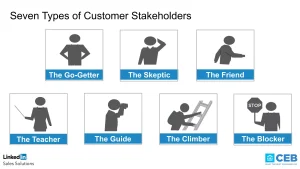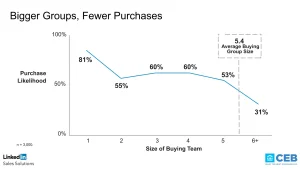This is a level 100 Introduction article to introduce new folk to the landscape of SaaS sales in a cloud marketplace. The 200 Intermediate, 300 Advanced, and 400 Expert will come later -- if there's demand!
Nudge meSteve Chambers
I was only half-joking before when I said “Yer gonna need a bigger boat” in 5.4 Challenging Reasons Your SaaS Needs a Sales Team.
This post is an introduction — a skeleton, maybe — of how to build that bigger boat to help SaaS sales land those big deep-water enterprise fish. And not die trying.
Before we get into it, let me mention some people and resources that this post is aligned to: there’s a whole industry of people out there doing this stuff.
- For experienced SaaS sales leadership, check out Kyle Heisner who I’ve known for a few years and is the best SaaS sales practitioner I know. He totally gets SaaS, marketplaces, and is covered in grease from being inside the machinery. He helps SaaS companies go to market, sitting in the cab with them, helping them change gear, steer, and put the pedal-to-the-metal! His partner in crime is the excellent Kevin Flitcroft — both great people and deeply knowledgable.
- Via Kyle I learned about this Partner Insights course Cloud Marketplaces course that is the basis for this post – no affiliation. I think each of the 7 topics is spot on, as you would expect from experts, so I’m going to touch on them here and then dig deep in other posts later.
- Kyle and Kevin are working for a cloud marketplace accelerator (their words) called Suger.io — check them out too, and their CEO, Jon Yoo, who posts insightful content.
1. Crafting an actionable Marketplace Strategy
There is advice on the AWS Partner and Marketplace sites on how to build a strategy. Here’s an complementary and well-aligned set of steps with some real-world embellishments.
Go through these with your team — I recommend at least 4 of CxO, Sales, Alliance/Ops, Product/Service.
This is focused on AWS Marketplace because it’s the leader today.
If I was an ISV thinking of SaaS on cloud from the start, I’d be looking for a partner to help me get there… I have lots of anecdots of companies that went DIY and wasted months and money doing this the hard way.
BTW Have you done your positioning recently? You might want to revisit that.
- Product Fit Analysis
- Evaluate if your SaaS offering aligns well with the needs of AWS customers. You can’t just sell anything on AWS Marketplace — is it AWS adjacent?
- Identify the key customer personas and use cases your product serves best Real, relatable stories of real problems of real people.
- Determine which AWS services and solutions your product integrates/complements with. You have to be “AWS Adjacent”. It’s not a bring-and-buy sale.
- Go-To-Market Planning
- Define your pricing and packaging models for the AWS Marketplace. This is non trivial. Are you still selling a perpetual $1m licence, or moving to subs? To which units? There are many options here. Don’t try to be clever and fail by confusing the customer.
- Explore different deployment options (AMI, Container, SaaS Subscription). You might think SaaS is the option here… but…
- Plan for meeting the AWS Marketplace operational requirements. Someone needs to become an expert. More than one. In fact, partner with an expert. If your one expert is run over by a bus… where are you then? This is core business operations, not a weekend in Rhyl.
- Develop marketing content tailored for AWS customers (demos, tutorials, etc.). All cloud partners have marketing support, but it’s pretty average. If you just use that, you won’t stand out. Follow and then exceed their guidelines.
- Co-Selling Enablement
- Engage with the AWS SaaS Factory teams to enable co-selling. Remember this is a solved problem. You’re not a pioneer. You’re trying to hitch your horse to the cart.
- Get trained on AWS SaaS enablement programs and funding opportunities. Presume you know nothing. Even if you know 90% of what you learn, that last 10% might be a game changer.
- Plan joint marketing campaigns with the AWS field marketing teams. They want you to win, and that means turning up and playing. They aren’t going to give you a bye.
- Identify potential co-sell AWS SaaS partners and explore co-sell opportunities. Don’t be a loner: get out there and mingle. Create joint success. It might feel like more work at first, but you’ll be getting a slice of a bigger pie.
- Technical Integration
- Ensure product integration with relevant AWS services (e.g. identity, monitoring). You have to do the cloud providers standards. No free passes. You might have to do more coding.
- Implement AWS CloudTrail for governance and operational analytics. A proper SaaS company knows this is essential. But these are “on-cloud” analytics, what about your “in-SaaS” analytics, which are different?
- Leverage AWS quick starts and reference architectures where applicable. Don’t reinvent the wheel.
- Attain relevant AWS Competencies (e.g. ML, Migration, etc.). Invest in your people.
- Operations and Support
- Define your SLA terms for AWS Marketplace and support model. Pinch the SLA of someone similar: can you do it? Tweak it. Do risk assessment. Model the worst case. Get COO/CFO sign off.
- Set up AWS Marketplace metering, billing and operations. Please use a partner for this. You don’t want to do this by hand. Trust me.
- Plan for meeting the AWS Operational Requirements This has to be an operational pillar that everyone understands and maintains.
- Provide AWS Trusted Advisor checks for your listed products. Trust is a big green customer tick. Win over the skeptic, mobilize the buyer!
- Growth Strategy
- Have a roadmap for enhancing product capabilities on AWS. How adjacent are you? When AWS do the next big thing.. do you?
- Explore expansion opportunities (e.g. new regions, pricing models). The big thing about AWS et al is their “globality” — can you sell beyond your current borders?
- Continuously improve your AWS Marketplace listings and merchandizing. What’s the routine and cadence? Are you learning? Improving? When you look back in 90 days, did you do better or worse, and was it your fault or someone else’s?
- Analyze AWS Marketplace performance metrics and optimize. There are multiple reports, but also use a partner tool for this. Compare yourself to another similar SaaS partner. Remember, you’re not Cinderella.
2. Creating internal buy-in from C-suite
SaaS on cloud marketplace is strategic, fundamental, game-changing and definitely a leadership-led thing. It’s not one-person “let’s give it a go” test.
Mature cloud partners like AWS have business case templates: but don’t think you can take your brain out and just fill this in with AI. You need to do the work.
- Build a Compelling Business Case
- Quantify the potential revenue upside from AWS Marketplace (e.g. expanding to new customer base, enabling cloud consumption). Might be guess work for you: do worst case/most likely/best case. Read case studies for similar SaaS companies at your stage. You’re probably not Atlassian or Monday.com, so don’t worry.
- Highlight success stories of similar SaaS companies that leveraged AWS Marketplace effectively. Your cloud partner can help you with this. Remember, your success is their success. Ask them for stories of similar companies. Find an achievable aspirational story.
- Outline strategic benefits – better product discoverability, streamlined procurement for customers, co-sell opportunities. What’s in it for you? What are the downstream benefits for all this activity and investment?
- Mitigate Perceived Risks
- Address concerns around revenue cannibalization by existing sales channels. Happens all the time. Mis-aligned incentives, corrupted fiefdoms: you need to re-tarmac the drive.
- Explain how you will still maintain control over pricing, packaging, terms. Marketplaces are the most transparent pricing and packaging systems EVER.
- Showcase the operational best practices and support provided by AWS Marketplace. In early days, showcase other similar companies. Then show what you want to be, but where you are now. Then show, over time, how you are getting there. BTW Marketplaces are not static things.
- Align with Company Initiatives
- Map how an AWS Marketplace strategy accelerates key cloud initiatives – migration, SaaS transition, etc. Is marketplace “on the side” or “up the middle”? A nice to have or a must have?
- Highlight AWS Marketplace as an enabler for achieving certain revenue, growth or customer experience goals. “We won’t achieve X with Y. Y being marketplace”.
- Positioning on AWS strengthens reputation as an innovative, cloud-first company. If you work with a cloud hyperscaler and do it well, doors are already being opened for you.
- Propose a Phased Approach
- Recommend starting with a pilot or minimum viable product (MVP) listing. Instead of Minimum Viable, do Minimum Lovable.
- Phase 1: Meet basic AWS Marketplace requirements to list and transact. Please use a partner.
- Phase 2: Integrate deeper with AWS services, co-sell motions after validating demand. Please use a partner.
- Robust Execution Plan
- Present a clear, comprehensive, and timebound execution plan covering all strategy elements. You plan v1 — just get it done. You plan v2 will be better. plan v3 will be awesome. Just get a plan down to the best of your ability. Don’t be afraid to get it wrong: you’ll learn loads => better plan.
- Define measurable milestones, KPIs to track progress and ROI. You have in-SaaS KPIs like Churn, Refunds, etc. but you need in-Marketplace KPIs around fulfilled orders, revenue, commission etc. Make sure this is tied TIGHT to sales commissions.
- Identify any additional resources/investments required and tie it to expected returns. Getting on the marketplace is just step 1. Don’t starve your marketplace. Don’t let it die on the vine, then blame marketplace for your lack of investment.
- Leverage Third-Party Validation
- Bring in AWS Marketplace experts to answer C-suite questions directly. The AWS team are great, but leverage the amazing SaaS and Cloud Marketplace community, people like Kyle and Kevin, and companies like Suger.
- Share insights from analyst reports on the growing cloud marketplace ecosystem. A lot of these are “big picture” and not actionable. Look at Bessemer and the other usual suspects.
- Cite feedback from customers demanding to procure your solution on AWS Marketplace. Some customers will ONLY procure via marketplace. Tell this truth to the world, because there’s a lot of non-believers out there.
3. Dissecting differences between marketplaces
There’s not just one marketplace: there’s the main western 3 (AWS, Azure, GCP) — which are all different — plus Alibaba… then you have app marketplaces like Salesforce: where do you fit?
- Customer Base and Market Reach
- Analyze the respective customer bases of each cloud provider’s marketplace. You’ll only get huge numbers unless your partner will give you detailed statistics: it’s in their interest to get you aligned with customers/markets, but they won’t let you fish in open waters.
- Which industries/verticals do they have a stronger presence in? You can ask them, but also scent their strength via their case studies and resources. GCP is stronger in some markets than AWS etc. The point is: what’s YOUR industry (are you vertical or horizontal SaaS?).
- Consider the geographic reach and any regional marketplace strengths. Sometimes you want to exclude geographics, sometimes you want to use marketplaces to stretch into others.
- Technical Integration Capabilities
- Evaluate integration points with native cloud services (e.g. identity, monitoring). Definitely make your SaaS cloud native. Per cloud.
- Review marketplace deployment models supported (AMI, containers, SaaS etc.). Integrate this into your DevOps CI/CD build process.
- Assess ease of leveraging cloud provider’s DevOps, CI/CD, and management tooling. See above. Do it! Hand crafting and uploading deployments manually is MADNESS.
- Co-selling and GTM Partnership Opportunities
- Understand co-selling motions, enablement programs and incentives for partners. Partnering with an alliance team mate is crucial here. It’s a full time job keeping up with this stuff, so someone needs to distill it into what it means for you and what to do.
- Identify potential co-sell partners or ISVs to create solution bundles. If you do services, which products can you wrap around? If you do software, what services can be wrapped around? Loads of ideas here.
- Review any industry-specific GTM programs or verticals they prioritize. Whether you’re vertical or horizontal, there’s *always* some events and GTM activities ongoing.
- Operational Capabilities and Requirements
- Compare metering, billing, and financial operations models. This is the painful bit, at first. This is why you need a partner tool to take the pain away.
- Evaluate marketplace operational benchmarks, support processes. Do you want to pay a team of 4 to run this? Or is there a better way?
- Assess reporting, analytics and marketplace insights capabilities. Remember signal:noise ration, don’t flood yourself.
- Pricing Models and Payment Flows
- Explore pricing models supported (BYOL, Pay-as-you-go, annual subscriptions). Don’t just follow the crowd… what do you fancy? What would be great for customers? Different prices and models for different buyers is fine: especially for the risky/fraudulent ones (you got that?)
- Understand payment flows, revenue shares, and negotiating power. Your CFO should never be surprised. Don’t be a pain in their ass, just be another line on their spreadsheet. A green line 😉
- Evaluate product bundling opportunities with native cloud services. Instead of just sitting on the cloud, could you bundle other things in an re/co-sell?
- Regulatory Compliance and Security Certifications
- Review industry compliance certifications (HIPAA, FedRAMP, etc)
- Assess data residency, privacy, and security controls
- Identify any marketplace security automation and controls
4. Building robust relationships with the clouds
Each cloud is different in many ways, I know it’s obvious, but with the “multicloud” brigade trying to simplify things… they got nowhere. Each cloud has different programs, interfaces, languages, practices, etc.
What is the same for them all, however, is you have to spend face time with them and get to know them IF YOU WANT TO DO WELL.
You must consume their programs and talk their language. For example, the AWS team will want to know your super power: what is it?
Other things:
1. Engage with the AWS SaaS Factory Teams
- Connect with the dedicated AWS SaaS Factory teams that enable and support ISVs/SaaS companies. Face time with the main team in your geography is crucial. I know we’re all “remote” these days, but you need to build relationships with people.
- Leverage their expertise on the AWS Marketplace go-to-market motions, best practices, and partner programs. Don’t be afraid of looking dumb. But don’t ask dumb questions.
- Discuss co-selling opportunities and get enabled on AWS co-sell processes. Increase the size of the pie for everyone. Raise the tide; lift all boats.
2. Join Relevant AWS Competency Programs
- Attain AWS Competencies relevant to your SaaS solution (e.g. Microsoft Workloads, Migration, Machine Learning). Remember that when your staff with the cert leaves, so does the cert.
- Get access to AWS Competency Partner incentives, resources, and support. Much like the marketing incentives, the Alliance leader should be squeezing this hard. It will cost you, too.
- Showcase your AWS expertise to customers through competency badges. Some people blow their trumpet, others don’t even tell folk they have a trumpet. It might not be a direct SaaS benefit to your customers, but it’s an indirect, trust benefit. If you’re ace at Cloud, you’re probably ace at SaaS.
3. Participate in AWS Partner Initiatives
- Get involved in AWS Partner Paths for SaaS, ISVs based on your product/growth stage. This is important — not just the path, but your stage. You can’t act like Twilio in month 1.
- Attend AWS Partner exclusive events, bootcamps, and workshops. Face time, networking. It’s not just AWS and partners that are there… you find out about customers, practices, and more.
- Engage with AWS Partner SA team for architecture reviews and certifications. Even if you can’t get time with one — and they are ace — they publish their standards so the least you can do is meet those. If you are different: tell them! They love something new (better?).
4. Collaborate on Joint Marketing Activities
- Work closely with AWS marketplace/partner marketing teams
- Coordinate joint co-branded campaigns, webinars, customer references
- Leverage AWS industry SMEs for creating marketing content
5. Leverage AWS Funding Programs
- Apply for relevant AWS reserve instance pricing benefits and funding initiatives
- Explore AWS Marketplace Utility Seller and Revenue Share tiers
- Maximize AWS funding vehicles like the AWS Co-Sell program
6. Build Relationships at Different Levels
- Connect with your AWS Partner Development Representative (PDR)
- Engage with relevant AWS SAs and SEs for technical collaboration
- Network with AWS Marketplace leadership at events and summits
5. Understanding listings, integration, and automations
This is where the rubber meets the road. The mechanics of cloud marketplaces are difficult. This is why companies like Suger.io, Labra.io and others have emerged.
1. Marketplace Listings
- Understand the different listing types (AMI, Container, SaaS Subscription, etc.) — where do you fit?
- Optimizing your product listings with compelling descriptions, images, videos. Get a copywriter.
- Leveraging listing badges, customer reviews, and social proof. This is what lazy or less good marketplace traders are bad at.
- Pricing models supported (BYOL, Pay-as-you-go, Contract pricing, etc.). You need to work these numbers and understand down-stream financial operations.
- Processes for listing updates, versions, and delisting. Who’s doing it? What triggers it? What’s your guide? Is it automated?
2. Technical Integration
- Identity integration with marketplace’s user directory (e.g. AWS SSO)
- Integrating with native cloud services (e.g. monitoring, logging, databases)
- Automating deployment using IaC tools and cloud provider’s CI/CD services
- Implementing cloud provider’s security and compliance controls
- Leveraging quick starts, solution architectures, and reference deployments
3. Billing Integration and Metering
- Integrating with marketplace metering and billing systems. You might have to change your code.
- Supporting customer’s procurement models (On-Demand, Subscriptions, etc.). Have you set up customer success?
- Managing licenses, entitlements, and reporting obligations. Here’s the link between your product, the marketplace, and your operations.
- Automating billing operations, invoicing, and revenue share calculations. You do not want to do this manually. Trust me. Been there.
- Tax handling, payments, and financial operations integration. Errors over here are terrors over there.
4. Operations Automation
- Leveraging marketplace’s operational best practice programs
- Automating provisioning, management, patching, and upgrades
- Integrating with cloud provider’s management and automations services
- Implementing monitoring, logging, and analytics
- Enabling self-service support models and creating knowledge bases
5. Marketplace Analytics and Insights
- Understanding reporting metrics for marketplace performance
- Integrating with cloud provider’s marketplace insights and analytics
- Leveraging analytics for demand forecasting and inventory management
- Extracting sales performance, pipeline metrics, and funnel analytics
- Tracking customer acquisition, retention, and renewal metrics
6. Mastering the art of Co-Selling
Selling SaaS via cloud marketplaces is not direct selling (because you’re partnering with the cloud team), but it’s not traditional distribution/reselling channel either.
This is absolutely the wheelhouse of the SaaS sales team!
1. Understand Cloud Provider’s Co-Sell Motions
- Get trained on the specific co-sell processes, playbooks and incentive programs offered by cloud providers like AWS, Azure, GCP
- Study the defined roles – Cloud SEs, SAs, Partner SAs, Partner Delivery Partners
- Familiarize with co-sell tools, deal registration processes and approval workflows
2. Identify Strategic Co-Sell Opportunities
- Map your SaaS solution’s value props to the cloud provider’s prioritized workloads/scenarios
- Research existing cloud provider service partners to explore complementary solution bundles
- Evaluate partners with similar client base for potential cross-sell and co-sell plays
3. Enable Sales for Co-Sell Conversations
- Arm sales teams with battle-cards highlighting your cloud differentiation
- Develop mutual pitch decks, ROI calculators, and standardized cloud demo workflows
- Prepare teams to position and lead with the cloud provider’s services first
4. Foster Relationships with Cloud Sales Teams
- Connect with the cloud provider’s SEs, SAs, Partner SAs locally and regionally
- Participate in joint cloud practice builder sessions and cloud enablement events
- Collaborate on account mapping and pipeline generation activities
5. Leverage Cloud Marketplace for Co-Sell
- Optimize product listings on the cloud marketplace for visibility and buyer’s journey
- Implement technical validation, deployment guides, and cloud design patterns
- Access co-sell ready services and solution maps for positioning bundles
6. Measure and Continuously Improve
- Define co-sell KPIs around co-sell pipeline, wins, cloud consumption metrics
- Leverage co-sell performance scorecards and analytics for coaching
- Capture voice-of-customer feedback to enhance co-sell plays and cloud value props
7. Marketing in the clouds
Listing on a marketplace and expecting business is akin to a tree falling in a forest with nobody there to witness it: did it make a noise?
When you understand that the cloud marketplace is a fulfilment channel, and that you have to do marketing on top of it, then you won’t suffer what some companies do: dry, dead, dusty listings.
My top-level advice is to make sure you interlink your website and other marketing assets to your marketplace listing. Make sure people can find it.
Other high-level actions — you might laugh, but often marketplace listing are the bare minimum and they make a poor company impression.
Optimize Your Listing: Ensure that your product listing on the AWS Marketplace is optimized for search. This includes using relevant keywords in your product title, description, and metadata to improve discoverability.
Create Compelling Product Descriptions: Craft engaging and informative product descriptions that highlight the key features, benefits, and use cases of your SaaS solution. Use clear language and provide enough detail to help potential customers understand how your product can address their needs.
Utilize High-Quality Visuals: Include high-quality images, screenshots, and videos that showcase your product’s user interface, functionality, and value proposition. Visuals can significantly enhance the appeal of your listing and help potential customers better understand what your product offers.
Leverage Customer Reviews and Ratings: Encourage satisfied customers to leave positive reviews and ratings for your product on the AWS Marketplace. Positive feedback from other users can build trust and credibility, making your product more attractive to potential customers.
Offer Free Trials or Demos: Provide free trials or demos of your SaaS product to allow potential customers to experience its features and capabilities firsthand. This can help drive adoption and convince prospects to make a purchase.
Promote Your Listing: Promote your product listing on the AWS Marketplace through various channels, including your website, social media profiles, email newsletters, and online advertising campaigns. Consider leveraging AWS-specific marketing channels and partnerships to reach a broader audience of AWS users.
Optimize Pricing and Packaging: Evaluate your pricing strategy and packaging options to ensure they align with the needs and budgets of your target customers. Consider offering flexible pricing plans, discounts for annual subscriptions, and special promotions to attract new customers and encourage conversions.
Monitor Performance and Iterate: Regularly monitor the performance of your product listing on the AWS Marketplace, including metrics such as clicks, conversions, and customer feedback. Use this data to identify areas for improvement and iterate on your marketing strategy to maximize results over time.




